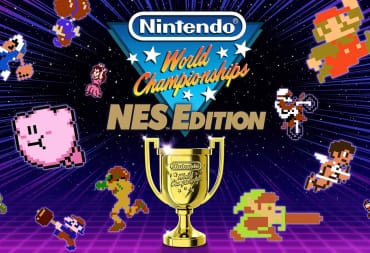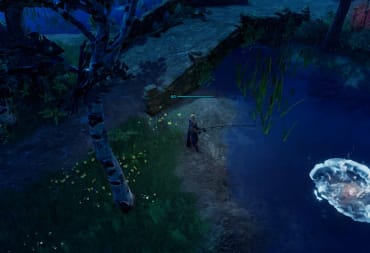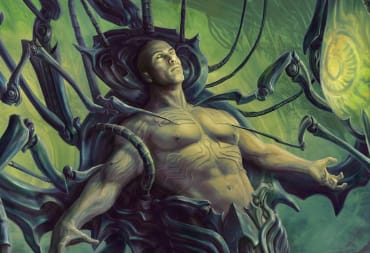Eldritch Moon is the second set in the Shadows Over Innistrad block, Wizards of the Coast’s return to the much-beloved world of Innistrad. Released on July 22, 2016, this set ended the second block in the new Magic: The Gathering block format, in which blocks would consist of two sets, not three, and Standard rotation would happen on a much more frequent basis. To see what we thought of the previous block, check out our reviews for Battle for Zendikar and Oath of the Gatewatch.
Today, TechRaptor will be taking a look back at Eldritch Moon from a competitive standpoint, looking at how well the set performed in the Limited Draft and Sealed formats, and looking at what contributions the set made to Standard and the non-rotating formats of Modern, Legacy, and Vintage. We’ll also be looking at Eldritch Moon from a setting viewpoint, seeing how well it not only carried on the original Innistrad‘s flavor and themes, but the flavor and themes started in Shadows Over Innistrad.
Sorin Markov's unmaking of Avacyn turns out to be exactly what his once-comrade Nahiri had wanted him to do. Desiring revenge over Sorin turning his back on her home plane of Zendikar and locking her into the Helvault, Nahiri made plans to summon the final Eldrazi Titan, Emrakul, to ravage Sorin's home plane of Innistrad and force him to watch his world collapse in the same manner hers did. As Emrakul rises, her presence drives the inhabitants of Innistrad mad and causes them to transform into eldritch Eldrazi abominations. While Jace escapes to gather the Gatewatch, the forces of Innistrad gather to defend their world from the horrors Nahiri has brought to them.
Eldritch Moon handled the collapse of a plane much more gracefully than the Battle for Zendikar block did. Over the course of the set, we really get the feeling that the events that are unfolding have a major impact on the world, and that the stakes are very, very high. The effects of Nahiri's machinations support this feeling: the protector of the world is dead, unmade by the hand of her very creator; her protections which kept the world safe have been forever undone; the Church of Avacyn has been infiltrated and corrupted by cultists at every level of office; the self-proclaimed "Lord of Innistrad" has been brought down by his own hubris and encased in an en-inescapable stone prison and the plane's faith has been shattered. As every story in the set unfolded, and as more and more of the cards in the set were revealed, I felt drawn further and further into the lore, just as I was in the original Innistrad block.

I also felt the Eldrazi in this set were integrated much more fluidly into the themes and flavors of Shadows Over Innistrad than they were with the Battle for Zendikar block. My biggest complaint about the representation of the Eldrazi in Battle for Zendikar was that, compared to their original iterations in the Zendikar block, they were completely different to the point that, had they not had the Eldrazi creature subtype, I wouldn't have thought them to be Eldrazi. In Eldritch Moon, that wasn't the case. The presence of the Eldrazi alongside the gothic horror elements of Innistrad gave the set a very strong Lovecraftian theme and illustrated perfectly just how alien and otherwordly the Eldrazi really are.
However, I really dislike how the Eldrazi—once described as one of the biggest threats to the multiverse, on par with the Phyrexians—were completely nullified over the course of two blocks. We're led to believe that these creatures were so powerful that despite the best efforts of three pre-Mending Planeswalkers, the best they could do was to confine the Eldrazi to Zendikar and hopefully be able to recontain them in the event that they escaped. Instead, Ulamog and Kozilek's material manifestations were destroyed during the events of Oath of the Gatewatch, and Emrakul was sealed into Innistrad's silver moon (an event that she not only willingly let happen, but even helped come to pass).
Two of the three mechanics introduced in Shadows Over Innistrad, Delirium and Skulk, make a return in Eldritch Moon (Investigate was sadly left out due to "the clue-gathering part of the story [being] over"). Both Delirium and Skulk return with very few changes made to their design spaces; Delirium occupies a tad more of the "changes to power and toughness" space as a result of double-faced cards occupying a new niche, as seen with Desperate Sentry.
The niche that Transform and double-faced cards occupied in Eldritch Moon was very interestingly done. In the original Innistrad block and in Shadows Over Innistrad, the front side of the card represented a "benign" creature, with the transformed back side representing their monstrous counterpart. In Eldritch Moon, most of the double-faced cards had the monstrous form as the front side of the card, with a horribly mutated version as the back side. This approach led to evolutions in design space for double-faced cards like the Werewolves, which typically have two transformation triggers—one to flip the front to the back, and one to flip the back to the front (see Huntmaster of the Fells // Ravager of the Fells as an example). With the exception of Ulrich of the Krallenhorde // Ulrich, Uncontested Alpha, the Werewolves in this set only have one transformation trigger into their mutated Eldrazi form - see Kessig Prowler // Sinuous Prowler. While this helped to distinguish Eldritch Moon doubled-faced cards from Shadows Over Innistrad double-faced cards, it also was a perfect fit of store and gameplay; the influence of Emrakul is permanent, and you can't undo the mutation.
In addition to the two original mechanics of Shadows Over Innistrad, Eldritch Moon introduces three new mechanics: Meld (combines two of the appropriate cards into one), Escalate (modal instants and sorceries with an additional cost for each mode chosen beyond the first), and Emerge (alternate casting cost that involves sacrificing a creature, and reducing the Emerge cost by the sacrificed creature's converted mana cost). Additionally, Madness and Transform from Shadows Over Innistrad make a return in this set. Of the three new mechanics, I think Emerge and Escalate were handled the best and had plenty of design space to be explored in. Cards like the Collective Escalate cycle (Collective Brutality, Collective Defiance, and Collective Effort) Elder Deep Fiend allow for a lot of flexibility in usage.
Meld wasn't explored in as much depth as the other two mechanics, appearing on a grand total of six cards (Graf Rats, Midnight Scavengers, Hanweir Battlements, Hanweir Garrison, Gisela, the Broken Blade and Bruna, the Fading Light). It seems that Meld was mostly included as an extension of the story, rather than a mechanic to be explored in terms of design space, and that bums me out a little bit as it's an interesting design space to explore not only as a mechanic, but also as an evolution for double-faced cards. Given that the Magic Story makes frequent reference to various humans and objects melding together as a result of Emrakul being on Innistrad, it might have been a mechanic that was more prominent in the early design stages of the set before being whittled down either due to being over-centralizing or not working well with cards from other sets. Head Designer Mark Rosewater at least acknowledges that not having more cards featuring Meld was a design mistake, so we may see it return in a thematically relevant set in the future.
The strong mechanics, and the fact that the Limited environments contained packs of the similarly strong Shadows Over Innistrad, meant that the Limited format had several strong, well-supported archetypes. Green/White Humans, by far the strongest of the Limited archetypes from Shadows Over Innistrad, is similarly strong here thanks to inclusions such as Thalia, Heretic Cathar and Heron's Grace Champion. While Green/White Humans retains its strength, other archetypes gain valuable additions that put them near the same level of strength—Red/Green Werewolves gets Ulrich of the Krallenhorde // Ulrich, Uncontested Alpha, Blue/Black Zombies gets Gisa and Geralf and Cryptbreaker, White/Blue Spirits receives Spell Queller and Mausoleum Wanderer, and Black/Green Delrium got Grim Flayer. These strong additions to these Limited archetypes meant that Draft and Sealed events were fun to play in, and deck construction was an interesting, stimulating experience.

The Standard Magic: The Gathering format saw the strong and popular Green/White Humans deck evolve into Bant Humans thanks to the printing of Spell Queller. It wasn't until Dragons of Tarkir and Magic Origins rotated out of Standard that the deck became more manageable, and the new Red/White Vehicles deck of Kaladesh-era Standard has become the premier replacement. Even in post-Collected Company Kaladesh Standard, cards introduced in Eldritch Moon are still prominent. Cards like Emrakul, the Promised End provide a strong finisher, while Selfless Spirit allows Aggro decks to swing wide and not worry about losing any creatures to combat damage or an opponent's combat tricks (and additionally help to Crew some of the new Vehicle subtype artifacts).
Eldritch Moon hasn't had quite the impact on Modern and other formats as Shadows Over Innistrad has had. Some cards are being considered for use in decks, such as the aforementioned Thalia, Heretic Cathar and Harmless Offering, but it's a manner of finding the right decks for them to be used in and for the time being, those decks just haven't emerged yet. Bedlam Reveler has seen some use in Mono-Red Burn and Blue/Red Delver, but it's still very much a niche card in those decks.
Defining cards: Eldritch Moon continues the theme of strong, flavorful cards that Shadows Over Innistrad began. In addition to the cards mentioned throughout this article, there are many more cards that capture the themes and tone of the set. Delver of Secrets and Aberrant Researcher receive the final card in their vertical cycle, Docent of Perfection, which acts as a Lord for the Wizard creature sub-type. Fans who had long clamored for a Legendary Spider creature received one in Ishkanah, Grafwidow. Obviously, Eldrazi such as Emrakul, the Promised End and Brisela, Voice of Nightmares cover the original depictions of Eldrazi—large, monstrous, and incredibly hard to manage—but other cards such as Lone Rider // It That Rides As One, Grizzled Angler // Grisly Anglerfish, and Curious Homunculus // Voracious Reader help to capture the Lovecraftian horror elements that permeate throughout this set.
Notes on the Shadows Over Innistrad block: Overall, the Shadows Over Innistrad block was a very successful return to the plane of Innistrad and handles the change to the new block format much more successfully than Battle for Zendikar did. In all honesty, I would have liked to have seen Shadows Over Innistrad take place before Battle for Zendikar; the "mystery" of Emrakul appearing in Eldritch Moon was completely ruined by the prior block. I think having Jace accompany Liliana to Innistrad per her request in the "Catching Up" Magic Story, rather than go with Gideon to Zendikar, would have yielded a stronger flowing storyline and would have preserved the mystery of Emrakul's appearance in this block while still allowing for the large-scale, climactic battles of Battle for Zendikar and the formation of the Gatewatch.
Bottom line: Eldritch Moon is a strongly designed set that not only played well with the gothic horror themes of the original Innistrad block and the previous Shadows Over Innistrad but evolved those themes with Lovecraftian overtones thanks to the influence of Emrakul. The creative direction taken with mechanics and cards led to a strong, enjoyable experience. While the plotline's ending left much to be desired, the lore was well-represented, and as a result, the set is capable of standing on its own as an individual set while also fitting into the pre-existing universe of Magic: The Gathering.
The author of this review participated in Eldritch Moon drafts, Magic: The Gathering pre-release events, Standard format competitions and purchased Eldritch Moon product at his local game store.
Review Summary
Eldritch Moon is a strongly designed set that not only played well with the gothic horror themes of the original Innistrad block and the previous Shadows Over Innistrad but evolved those themes with Lovecraftian overtones thanks to the influence of Emrakul. The creative direction taken with mechanics and cards led to a strong, enjoyable experience.
(Review Policy)Pros
- Strong Lovecraftian themes
- Strong presence in multiple formats
- Escalate and Emerge are both strongly explored in design
Cons
- Meld mechanic not fully explored
- Unsatistying end to Emrakul/Eldrazi plotline
Have a tip, or want to point out something we missed? Leave a Comment or e-mail us at tips@techraptor.net













